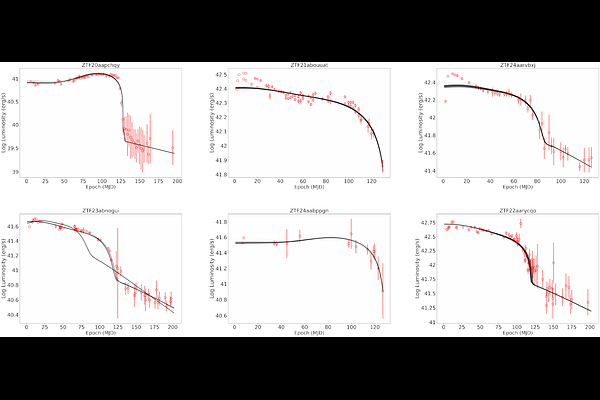Low-Luminosity Type IIP Supernovae from the Zwicky Transient Facility Census of the Local Universe. II: Lightcurve Analysis

Low-Luminosity Type IIP Supernovae from the Zwicky Transient Facility Census of the Local Universe. II: Lightcurve Analysis
Kaustav K. Das, Mansi M. Kasliwal, Jesper Sollerman, Christoffer Fremling, Takashi J. Moriya, K-Ryan Hinds, Daniel A. Perley, Eric C. Bellm, Tracy X. Chen, Evan P. O'Connor, Michael W. Coughlin, W. V. Jacobson-Galan, Anjasha Gangopadhyay, Matthew Graham, S. R. Kulkarni, Josiah Purdum, Nikhil Sarin, Steve Schulze, Avinash Singh, Daichi Tsuna, Avery Wold
AbstractThe Zwicky Transient Facility Census of the Local Universe survey yielded a sample of 330 Type IIP supernovae (SNe) with well-constrained peak luminosities. In paper I (arXiv:2502.19493), we measured their luminosity function and volumetric rate. Here (paper II), we present the largest systematic study of lightcurve properties for Type IIP SNe from a volume-limited survey, analyzing a selected subset of 129 events, including 16 low-luminosity Type IIP (LLIIP) SNe with M${r,peak} \geq -16$ mag. We find that plateau slope correlates with peak brightness, with many LLIIP SNe showing positive slopes--suggesting smaller progenitor radii and distinct density profiles compared to brighter Type IIP SNe. The plateau duration shows only a weak dependence on peak brightness, likely suggesting binary interaction. One SN exhibits a plateau-to-tail drop of >3.5 mag, consistent with an electron-capture or failed SN with very low or zero nickel mass. We derive explosion and progenitor parameters of the entire Type IIP SN sample using semi-analytical and radiation-hydrodynamical models. Based on radiation-hydrodynamical model fitting, LLIIP SNe are characterized by low nickel masses (0.001-0.025 $\mathrm{M_\odot}$), low explosion energies (0.1-0.28 $\times 10^{51}$ erg), low ejecta masses ($8.1^{+0.8}_{-1.7}$ $\mathrm{M\odot}$), and ZAMS masses below 11 $\mathrm{M_\odot}$. In comparison, the full Type IIP SN sample spans a wider range with nickel masses (0.001-0.222 $\mathrm{M_\odot}$), explosion energies (0.10-4.43 $\times 10^{51}$ erg), ejecta masses (5.4-24.8 $\mathrm{M_\odot}$), and ZAMS masses (9.3-16.7 $\mathrm{M_\odot}$). We find strong correlations between peak brightness, explosion energy, and nickel mass that extend to the low-luminosity end. We conclude that LLIIP SNe represent the faint, low-energy end of the Type IIP population and originate from the lowest-mass core-collapse progenitors.